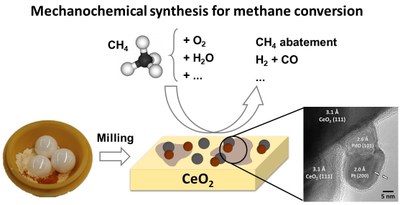DynaCatMe
Understanding the Dynamic Nature of Catalysts for Methane Abatement Reactions
In this project, we have developed new catalysts to abate and transform methane. Methane is a powerful greenhouse gas, with an effect 20 times higher than that of carbon dioxide. Therefore, it is crucial to control and prevent the emissions of unburned or unreacted methane to the atmosphere both in mobile and stationary applications such as natural gas-propelled vehicles or boilers. In this context, developing new catalysts with improved activity and higher stability is imperative to eliminate or convert methane. In this project, we have focused on the development of catalysts for the total oxidation of methane (MTO) in dry and wet conditions and the methane steam reforming (MSR).

Some relevant publications:
Bimetallic NiFe Nanoparticles Supported on CeO2 as Catalysts for Methane Steam Reforming
In this study, we have synthesized monometallic Ni and bimetallic NiFe catalysts supported on CeO2 for the methane steam reforming (MSR) reaction aiming at producing coke-resistant and noble-metal-free catalysts by traditional impregnation and mechanochemical methods. Iron addition affected the catalysts’ reducibility as inferred from temperature-programmed reductions. In situ near-ambient pressure X-ray photoelectron spectroscopy measurements revealed a distinct reorganization of the surface in the bimetallic catalysts with Fe segregation towards the surface during MSR. Raman analyses showed less carbon deposition and a more defective type of carbon formed on the surface of the catalysts containing 1 wt.% Fe, indicating an increased coke resistance for the bimetallic NiFe/CeO2 catalysts.
A. Braga, M. Armengol-Profitós, L. Pascua-Solé, X. Vendrell, L. Soler, I. Serrano, I. J. Villar-Garcia, V. Pérez-Dieste, N. J. Divins, J. Llorca. Bimetallic NiFe Nanoparticles Supported on CeO2 as Catalysts for Methane Steam Reforming. ACS Applied Nano Materials 6, 7173–7185 (2023).
In situ investigation of the mechanochemically promoted Pd–Ce interaction under stoichiometric methane oxidation conditions
In this study, we optimize Pd/CeO2 catalysts designed for the efficient abatement of methane in natural gas-fuelled vehicles. By operando synchrotron near-ambient pressure X-ray photoelectron spectroscopy (NAP-XPS) and X-ray diffraction measurements, we unravel a stable Pd0/Pd2+ arrangement in a ratio ca. 1 as the most active state of Pd to activate methane. The mechanochemically prepared catalysts showed higher activity and stability than the traditionally synthesized catalysts under reaction conditions with low oxygen content, up to 10% vapor content, and exposition to high temperature (700⁰C). The improved activity was ascribed to a promotional effect of the Pd-Ce interaction in the milled catalysts, as revealed by NAP-XPS measurements.
Danielis, N. J. Divins, J. Llorca, L. Soler, X. Garcia, I. Serrano, L. E. Betancourt, W. Xu, J. A. Rodríguez, S. D. Senanayake, S. Colussi, A. Trovarelli, In situ investigation of the mechanochemically promoted Pd–Ce interaction under stoichiometric methane oxidation conditions. EES Catalysis. 1, 144–152 (2023).
Investigation of the evolution of Pd-Pt supported on ceria for dry and wet methane oxidation
In this study, we investigated PdPt/CeO2 catalysts prepared by traditional impregnation and mechanochemically for the lean methane oxidation reaction in dry and wet conditions. This is a seminal work since we studied our catalysts with different operando techniques such as X-ray photoelectron and X-ray absorption spectroscopies, X-ray diffraction which provide information on the catalysts’ surface and bulk structure, and we combined these results with transmission electron microscopy and catalytic activity measurements. The operando measurements revealed that in the milled catalysts, Pd can be transformed to Pd oxide species strongly interacting with the support, and can achieve a modulated PdO/Pd ratio with higher ability than traditionally-synthesized catalysts. These results correlate with higher methane conversion and longer stability under wet lean methane oxidation conditions. Therefore, we demonstrate that the unique structures obtained at the nanometric level during milling are key to obtaining higher methane conversion and longer stability.
N. J. Divins, A. Braga, X. Vendrell, I. Serrano, X. Garcia, L. Soler, I. Lucentini, M. Danielis, A. Mussio, S. Colussi, I. J. Villar-Garcia, C. Escudero, A. Trovarelli, J. Llorca, Investigation of the evolution of Pd-Pt supported on ceria for dry and wet methane oxidation. Nature Communications 2022 131. 13, 1–11 (2022).
Share: